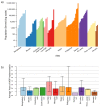Measuring the Impacts of Water Safety Plans in the Asia-Pacific Region
- PMID: 29890783
- PMCID: PMC6025033
- DOI: 10.3390/ijerph15061223
Measuring the Impacts of Water Safety Plans in the Asia-Pacific Region
Abstract
This study investigated the effectiveness of Water Safety Plans (WSP) implemented in 99 water supply systems across 12 countries in the Asia-Pacific region. An impact assessment methodology including 36 indicators was developed based on a conceptual framework proposed by the Center for Disease Control (CDC) and before/after data were collected between November 2014 and June 2016. WSPs were associated with infrastructure improvements at the vast majority (82) of participating sites and to increased financial support at 37 sites. In addition, significant changes were observed in operations and management practices, number of water safety-related meetings, unaccounted-for water, water quality testing activities, and monitoring of consumer satisfaction. However, the study also revealed challenges in the implementation of WSPs, including financial constraints and insufficient capacity. Finally, this study provided an opportunity to test the impact assessment methodology itself, and a series of recommendations are made to improve the approach (indicators, study design, data collection methods) for evaluating WSPs.
Keywords: Asia-Pacific region; drinking water quality; impact assessment; risk management; water safety plans.
Conflict of interest statement
The authors affiliated with WHO in this publication declare that WHO received funding for WSP implementation.
Figures




Similar articles
-
Observations and lessons learnt from more than a decade of water safety planning in South-East Asia.WHO South East Asia J Public Health. 2017 Sep;6(2):27-33. doi: 10.4103/2224-3151.213788. WHO South East Asia J Public Health. 2017. PMID: 28857060
-
Implementation of water safety plans in China: 2004-2018.Int J Hyg Environ Health. 2020 Jan;223(1):106-115. doi: 10.1016/j.ijheh.2019.10.001. Epub 2019 Oct 9. Int J Hyg Environ Health. 2020. PMID: 31606406
-
Ghana's water safety journey: A review of efforts toward a risked-based water quality management.J Water Health. 2024 Dec;22(12):2370-2384. doi: 10.2166/wh.2024.371. Epub 2024 Nov 29. J Water Health. 2024. PMID: 39733362 Review.
-
Assessing operational performance benefits of a Water Safety Plan implemented in Southwestern France.Perspect Public Health. 2018 Sep;138(5):270-278. doi: 10.1177/1757913918787846. Epub 2018 Jul 11. Perspect Public Health. 2018. PMID: 29993345 Free PMC article.
-
Comparing the German enabling environment for nationwide Water Safety Plan implementation with international experiences: Are we still thinking big or already scaling up?Int J Hyg Environ Health. 2020 Jul;228:113553. doi: 10.1016/j.ijheh.2020.113553. Epub 2020 Jun 7. Int J Hyg Environ Health. 2020. PMID: 32521480
Cited by
-
Status of Water Safety Plan Development and Implementation in Uganda.Int J Environ Res Public Health. 2019 Oct 24;16(21):4096. doi: 10.3390/ijerph16214096. Int J Environ Res Public Health. 2019. PMID: 31652957 Free PMC article.
-
Water safety plans for water supply utilities in China, Cuba, France, Morocco and Spain: costs, benefits, and enabling environment elements.Urban Water J. 2019;16(4):277-288. doi: 10.1080/1573062X.2019.1669191. Epub 2019 Sep 29. Urban Water J. 2019. PMID: 31768148 Free PMC article.
-
Time series study of weather, water quality, and acute gastroenteritis at Water Safety Plan implementation sites in France and Spain.Int J Hyg Environ Health. 2018 May;221(4):714-726. doi: 10.1016/j.ijheh.2018.04.001. Epub 2018 Apr 6. Int J Hyg Environ Health. 2018. PMID: 29678324 Free PMC article.
-
Capacity building and training approaches for water safety plans: A comprehensive literature review.Int J Hyg Environ Health. 2019 May;222(4):615-627. doi: 10.1016/j.ijheh.2019.01.011. Epub 2019 Feb 8. Int J Hyg Environ Health. 2019. PMID: 30744955 Free PMC article.
-
Comparative evaluation of risk management frameworks for U.S. source waters.AWWA Water Sci. 2019 Jan-Feb;1(1):e1125. doi: 10.1002/aws2.1125. Epub 2019 Feb 19. AWWA Water Sci. 2019. PMID: 31001606 Free PMC article.
References
-
- Prüss-Ustün A., Bartram J., Clasen T., Colford J.M., Cumming O., Curtis V., Bonjour S., Dangour A.D., De France J., Fewtrell L., et al. Burden of Disease from Inadequate Water, Sanitation and Hygiene in Low- and Middle-Income Settings: A Retrospective Analysis of Data from 145 Countries. Trop. Med. Int. Health. 2014;19:894–905. doi: 10.1111/tmi.12329. - DOI - PMC - PubMed
-
- World Health Organization (WHO) Guidelines for Drinking Water Quality. 3rd ed. World Health Organization; Geneva, Switzerland: 2004. [(accessed on 28 May 2018)]. Available online: http://www.who.int/water_sanitation_health/publications/gdwq3/en/
Publication types
MeSH terms
Substances
Grants and funding
LinkOut - more resources
Full Text Sources
Other Literature Sources
Medical

